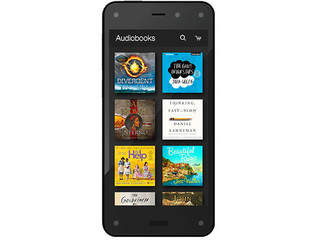
Fire Phone: Amazon's attack on brick-and-mortar stores
Amazon has made a policy of undercutting the competition. The Fire Phone closes the loop.

Amazon has a tough time making friends. The company’s cut-throat strategies to undermine its competitors—even competitors it relies on for sales of its own hardware—has made it something of a pariah among everyone from Walmart to indie stores.
The Fire Phone may be the final nail in the coffin.
The phone comes with tons of cool tricks and features—a 13 megapixel camera that appears to be quite competitive with those of iPhone and the Galaxy S5, that whole 3D “dynamic perspective” thing, and earbuds that miraculously don’t get tangled (??!?ARGLE FARGLE?!!?).
But the phone’s defining feature is Firefly, a breakthrough in showrooming technology that will finally allow Amazon to undercut EVERYONE.
A photo snapped at an independent bookstore has been making the rounds on Twitter and Facebook.

It pretty deftly sums up why everyone hates Amazon: the ultra-low-margin company continuously struggles to turn a profit (because it’s more focused on winning the e-commerce landgrab)—and it’s going to take everyone else down with it.
Everyone has done it: taken a picture of an item to look for it later on Amazon, or scanned a barcode to look for the same item for less online. But Firefly cuts out steps two and three. Now, by simply aiming your camera at the item and pressing the dedicated Firefly button on the side, you can find the item instantly on Amazon and buy it.
Naturally, that’s what Amazon got into the smartphone business for in the first place. Amazon didn’t just want to get into hardware for the sake of getting into hardware. The Kindle and the Kindle Fire were always designed from the beginning to drive content sales—first books, then movies and TV shows. Firefly will close the loop by driving product sales.
It’s what Amazon’s been trying to do for years now, and it pisses brick-and-mortar retailers right the f*ck off.
Back in 2012, Target and Walmart both gave Kindles and Kindle Fires the boot from their stores. While Walmart remained vague in its decision, Target was pretty explicit: it was sick of Amazon encouraging customers to shop at big box stores (like Target) and then find the same items on Amazon.com for less.
Amazon really pushed it in the 2011 holiday season when it offered a 5% off promotion for customers who used its Price Check app. In other words, it encouraged customers to go into a brick-and-mortar store, scan an item, and then purchase it through Amazon instead. (The Price Check app was already a little evil to begin with, since it was literally designed to target and redirect customers as they were getting ready to make a purchase in a brick-and-mortar store.)
What makes Firefly different from Price Check? Simple: it’s not as obvious. You can use Firefly to look up information on works of art in museums. You can use it to find out whether a phone number is real. And, oh yeah, you can also use it to scan items you see anywhere to find them on Amazon—from a dedicated button. That dedicated button also makes a big difference: it makes it simple, quick, and intuitive, so you don’t even have to download the Price Check app or pull up the Amazon app on your phone. For God’s sake, you don’t even have to snap an actual picture—you just point your phone and push a button.
The phone will retail for $199 (for the 32GB version), which means—like the Kindle Fire—Amazon is likely selling the phone at a breakeven price and counting on increasing product sales for its profits (the phone will also come with a free one-year Prime subscription, and Prime users have been shown time and time again to shop more often on Amazon and spend more—and those that renew for $99 a year are essentially handing Amazon $98 that go right into its coffers).
So what can we expect from the Fire Phone and how it will affect Amazon’s relationship with competing retailers? Well, for starters, we probably won’t see the Fire Phone on Walmart or Target shelves (not that their boycott had a negative impact on Kindle Fire sales). But we can probably also expect to get some serious side-eye from big box and indie retailers when we whip out our Fire Phones to scan an item.
Related News


Amazon to unveil 3D smartphone on June 18?

